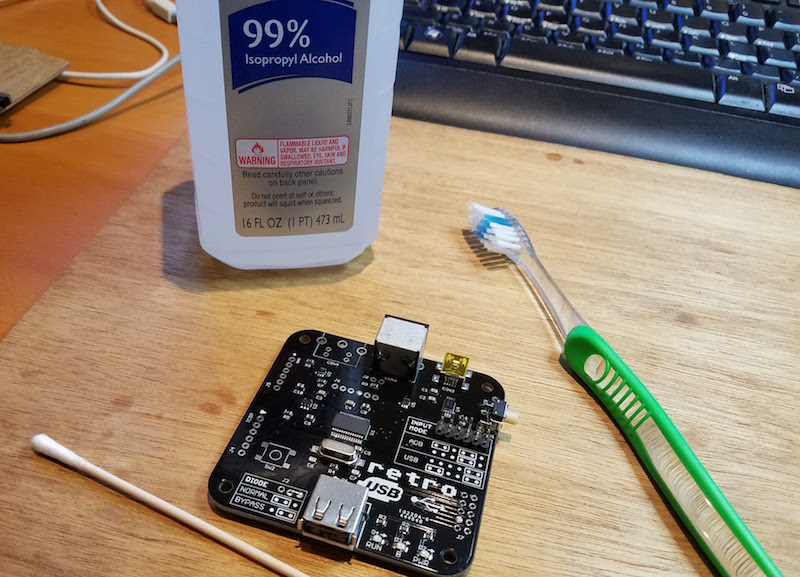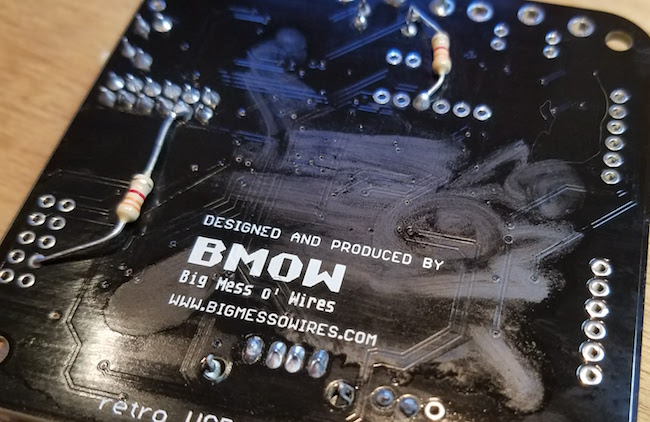How to Clean a PCB

Lately I’ve been assembling a lot of Retro USB boards, and that’s got me thinking about the best way to clean them after assembly. I use a “no clean” flux for my assembly work, so in theory I don’t have to have to clean it off, but if I don’t then it will leave an ugly sticky mess. Unfortunately the black soldermask of Retro USB boards seems to highlight flux residues more than other colors. I’ve also recently started using a gel flux in a syringe instead of a flux pen, and it’s stickier and leaves more residue. So good cleaning is more important now than ever.
In the past, my standard cleaning method was regular cotton swabs (Q-tips) with 99% isopropyl alcohol. It dissolves the flux residue, but the swabs snag easily on the sharp corners of parts, quickly become shredded, and leave tiny cotton fibers everywhere. I’ve now started using Chemtronics cotton tips, which are basically fancy Q-tips designed for industrial use. The cotton is packed and wound more tightly than Q-tips, and they’re “low lint”, whatever that means. It helps reduce shredding and stray cotton fibers, but doesn’t completely eliminate them.

The isopropyl alcohol also leaves a residue that’s visually unattractive, as you can see here. Its visibility depends greatly on the angle of the light, and I’ve intentionally chosen the worst angle for the photo. I’m uncertain if this residue is really from the alcohol, or whether it’s the remnants of the flux dissolved in the alcohol, but whatever it is leaves streaks on the PCB when it dries. I’ve found I need to wait until it dries, then use another dry cotton swab to buff the dried areas and remove the streaks. The end result still isn’t perfect, though it’s pretty good. But the whole cleaning process can be very time consuming, requiring several minutes per board.
It’s my understanding that commercial PCB assemblers wash the finished boards in hot deionized water and some kind of solvent. It’s essentially a special dishwasher for electronics. I don’t have that kind of equipment though, and I wouldn’t be excited about washing PCBs where my kitchen dishware and utensils go. In the past I’ve tried hand-washing finished boards with ordinary hot water and dish soap, and it worked OK but still wasn’t squeaky clean. Washed boards also require a special dryer, or a long period of air-drying to ensure all the water is out before powering the board.
Do you have a favorite method of board cleaning? Leave a note in the comments.
Read 8 comments and join the conversation8 Comments so far
Leave a reply. For customer support issues, please use the Customer Support link instead of writing comments.


I never used an Ultrasonic cleaner for PCBs, but I thought it would work. This link (https://www.sfcircuits.com/pcb-school/clean-pcbs-ultrasonic-cleaning) doesn’t recommend it, but you can buy one for ~$100 on eBay and try it. I definitely think it’s going to provide a great clean, just not sure how damaging it will actually be.
I had the same problem, then found spray-on flux remover from MG Chemicals. I’m sure there are other brands that work just as well.
I was skeptical but just as the directions said, two rounds of the stuff and my boards looked picture-perfect. I’m new to all this so the bonus was discovering my soldering was actually okay; I just couldn’t tell amidst the huge gobs of flux.
Downsides: aerosol can, deadly chemicals, requires a very well-ventilated area, careful handling, rubber gloves, and not all components like having flux removal pour through them (tact switches, LCDs, etc).
Try \”CRC Kontakt LR\” (http://www.kontaktchemie.com/KOC/KOCproductdetail.csp?product=KONTAKT%20PCC, available e.g. at https://www.amazon.de/dp/B003A6D06M). It\’s designed for \”invisible\” repairs, to remove dirt and especially to remove any remaining flux. And it leaves no residue. It comes with a spray-through brush that you can (and should) use to clean the PCB.
International name for the product seems to be \”Kontakt PCC\”.
Spray flux remover FTW.
I was unclear whether it’s just spray and done, or if you have to wipe or wash the flux remover off afterwards? Tetrismax’s aside about deadly chemicals, ventilation, rubber gloves, etc is also not inspiring, given that my work is done at home in a small room without great ventilation. I guess I could bring boards outdoors for a final cleaning step.
> spray and done, or if you have to wipe or wash the flux remover off afterwards?
I don’t know about other flux removers, but the MG product _is_ the wash. “Spray liberally and agitate with a toothbrush. If the board still looks a bit streaky, apply more,” says the manual.
I occasionally used a fan for drying because I was impatient, but letting it drip worked great as well (i.e., the boards looked perfect). 🙂
Mmm, watch out! I don’t think that toothbrush is ESD-safe. Granted, the resistance of the components to electrostatic discharge is much greater once they’re mounted on the board, but brushing with a non-ESD-safe brush isn’t considered best-practice, and you may eventually blow one of your more sensitive components (e.g. discrete MOSFETs)
Good point! I hadn’t considered that.